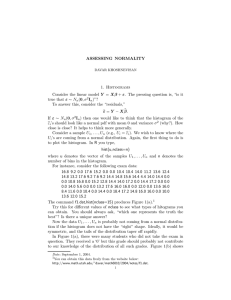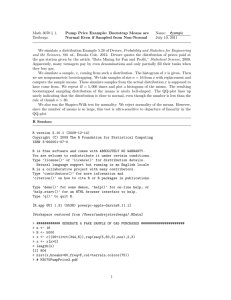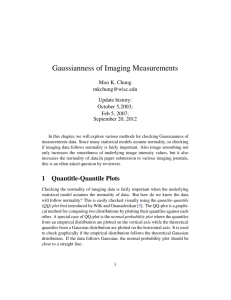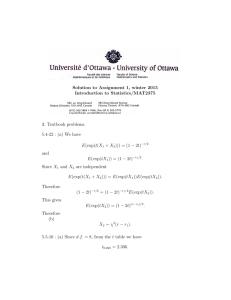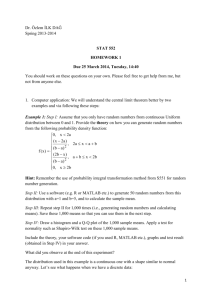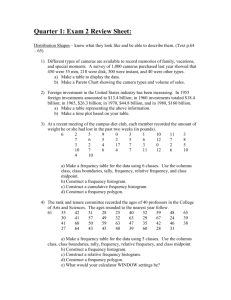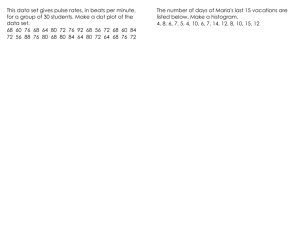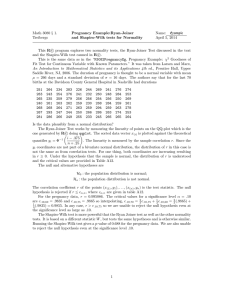Assessing Normality 1. Visual data exploration
advertisement
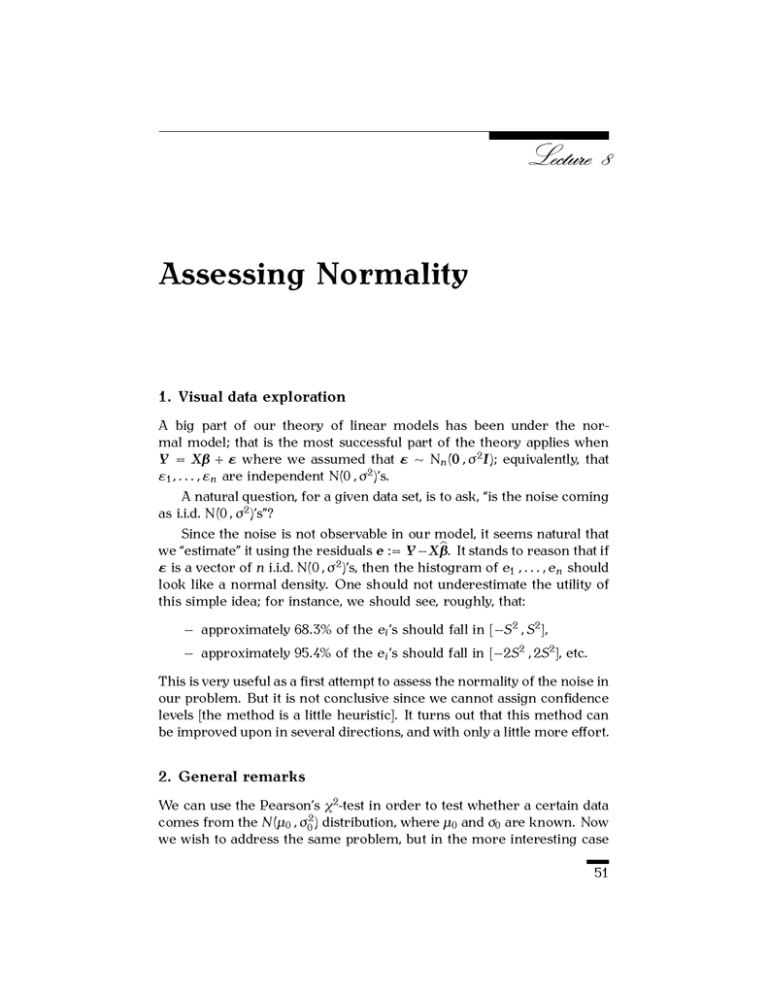
Assessing Normality
1. Visual data exploration
A big part of our theory of linear models has been under the normal model; that is the most successful part of the theory applies when
Y = Xβ + ε where we assumed that ε ∼ N� (0 � σ 2 I); equivalently, that
ε1 � � � � � ε� are independent N(0 � σ 2 )’s.
A natural question, for a given data set, is to ask, “is the noise coming
as i.i.d. N(0 � σ 2 )’s”?
Since the noise is not observable in our model, it seems natural that
� It stands to reason that if
we “estimate” it using the residuals � := Y −Xβ.
2
ε is a vector of � i.i.d. N(0 � σ )’s, then the histogram of �1 � � � � � �� should
look like a normal density. One should not underestimate the utility of
this simple idea; for instance, we should see, roughly, that:
− approximately 68�3% of the �� ’s should fall in [−S 2 � S 2 ],
− approximately 95�4% of the �� ’s should fall in [−2S 2 � 2S 2 ], etc.
This is very useful as a first attempt to assess the normality of the noise in
our problem. But it is not conclusive since we cannot assign confidence
levels [the method is a little heuristic]. It turns out that this method can
be improved upon in several directions, and with only a little more effort.
2. General remarks
We can use the Pearson’s χ 2 -test in order to test whether a certain data
comes from the N(µ0 � σ02 ) distribution, where µ0 and σ0 are known. Now
we wish to address the same problem, but in the more interesting case
51
52
8. Assessing Normality
that µ0 and σ0 are unknown. [For instance, you may wish to know
whether or not you are allowed to use the usual homoskedasticity assumption in the usual measurement-error model of linear models.]
Here we discuss briefly some solutions to this important problem.
Although we write our approach specifically in the context of linear models, these ideas can be developed more generally to test for normality
of data in other settings.
3. Histograms
Consider the linear model Y = Xβ + ε. The pressing question is, “is it
true that ε ∼ N� (0� σ 2 I� )”?
To answer this, consider the “residuals,”
�
� = Y − Xβ�
If ε ∼ N� (0� σ 2 I� ) then one would like to think that the histogram of the
�� ’s should look like a normal pdf with mean 0 and variance σ 2 (why?).
How close is close? It helps to think more generally.
Consider a sample U1 � � � � � U� (e.g., U� = �� ). We wish to know where
the U� ’s are coming from a normal distribution. The first thing to do is
to plot the histogram. In R you type,
hist(u,nclass=n)
where u denotes the vector of the samples U1 � � � � � U� and n denotes the
number of bins in the histogram.
For instance, consider the following exam data:
16.8 9.2 0.0 17.6 15.2 0.0 0.0 10.4 10.4 14.0 11.2 13.6 12.4
14.8 13.2 17.6 9.2 7.6 9.2 14.4 14.8 15.6 14.4 4.4 14.0 14.4
0.0 0.0 10.8 16.8 0.0 15.2 12.8 14.4 14.0 17.2 0.0 14.4 17.2
0.0 0.0 0.0 14.0 5.6 0.0 0.0 13.2 17.6 16.0 16.0 0.0 12.0 0.0
13.6 16.0 8.4 11.6 0.0 10.4 0.0 14.4 0.0 18.4 17.2 14.8 16.0
16.0 0.0 10.0 13.6 12.0 15.2
The command hist(f1.dat,nclass=15) produces Figure 8.1(a).1
Try this for different values of nclass to see what types of histograms
you can obtain. You should always ask, “which one represents the truth
the best”? Is there a unique answer?
Now the data U1 � � � � � U� is probably not coming from a normal distribution if the histogram does not have the “right” shape. Ideally, it would
be symmetric, and the tails of the distribution taper off rapidly.
1You can obtain this data freely from the website below:
http://www.math.utah.edu/˜davar/math6010/2011/Notes/f1.dat.
4. QQ-Plots
53
In Figure 8.1(a), there were many students who did not take the
exam in question. They received a ‘0’ but this grade should probably
not contribute to our knowledge of the distribution of all such grades.
Figure 8.1(b) shows the histogram of the same data set when the zeros
are removed. [This histogram appears to be closer to a normal density.]
4. QQ-Plots
QQ-plots are a better way to assess how closely a sample follows a certain distribution.
To understand the basic idea note that if U1 � � � � � U� is a sample from
a normal distribution with mean µ and variance σ 2 , then about 68�3%
of the sample points should fall in [µ − σ� µ + σ], 95�4% should fall in
[µ − 2σ� µ + 2σ], etc.
Now let us be more careful still. Let U1:� ≤ · · · ≤ U�:� denote the
order statistics of U1 � � � � � U� . Then no matter how you make things
precise, the fraction of data “below” U�:� is (� ± 1)/�. So we make a
continuity correction and define the fraction of the data below U�:� to be
(� − 21 )/�.
Consider the normal “quantiles,” �1 � �2 � � � � � �� :
�
�
� �� −� 2 /2
1
� − 21
�
−
e
2
√
Φ(�� ) :=
d� =
;
i.e., �� := Φ−1
�
�
�
2π
−∞
Now suppose once again that U1 � � � � � U� ∼ N(µ � σ 2 ) is a random [i.i.d.]
sample. Let Z� := (U� − µ)/σ, so that Z1 � � � � � Z� ∼ N(0 � 1). The Z’s are
standardized data, and we expect the fraction of the standardized data
that fall below �� to be about (�− 21 )/�. In other words, we can put together
our observations to deduce that Z�:� ≈ �� . Because U�:� = σZ�:� + µ, it
follows that U�:� ≈ σ�� + µ. In other words, we expect the sample order
statistics U1:� � � � � � U�:� to be very close to some linear function of the
normal quantiles �1 � � � � � �� . In other words, if U1 � � � � � U� is a random
sample from some normal distribution, then we expect the scatterplot
of the pairs (�1 � U1:� )� � � � � (�� ; U�:� ) to follow closely a line. [The slope
and intercept are σ and µ, respectively.]
QQ-plots are simply the plots of the N(0 � 1)-quantiles �1 � � � � � �� versus
the order statistics U1:� � � � � � U�:� . To draw the qqplot of a vector � in R,
you simply type
qqnorm(�)�
Figure 8.2(a) contains the qq-plot of the exam data we have been studying
here.
54
8. Assessing Normality
5. The Correlation Coefficient of the QQ-Plot
In its complete form, the R-command qqnorm has the following syntax:
qqnorm(u� datax = FALSE� plot = TRUE)�
The parameter u denotes the data; datax is “FALSE” if the data values are
drawn on the �-axis (default). It is “TRUE” if you wish to plot (U�:� � �� )
instead of the more traditional (�� � U�:� ). The option plot=TRUE (default)
tells R to plot the qq-plot, whereas plot=FALSE produces a vector. So for
instance, try
V = qqnorm(u� plot = FALSE)�
This creates two vectors: V$� and V$�. The first contains the values of
all �� ’s, and the second all of the U�:� ’s. So now you can compute the
correlation coefficient of the qq-plot by typing:
V = qqnorm(u� plot = FALSE)
cor(V$�� V$�)�
If you do this for the qq-plot of the grade data, then you will find a
correlation of ≈ 0�910. After censoring out the no-show exams, we
obtain a correlation of ≈ 0�971. This produces a noticeable difference,
and shows that the grades are indeed normal.
In fact, one can analyse this procedure statistically [“is the sample correlation coefficient corresponding to the line sufficiently close to ±1”?].
6. Some benchmarks
Figures 8.3 and 8.4 contain four distinct examples. I have used qq-plot in
the prorgam environment “R.” The image on the left-hand side of Figure 8.3 shows a simulation of 10000 standard normal random variables
(in R, you type x=rnorm(10000,0,1)), and its qq-plot is drawn on typing
qqnorm(x). In a very strong sense, this figure is the benchmark.
The image on the right-hand side of Figure 8.3 shows a simulation of
10000 standard Cauchy random variables. That is, the density function
is �(�) = (1/π)(1 + � 2 )−1 . This is done by typing y=rcauchy(10000,0,1),
and the resulting qq-plot is produced upon typing qqnorm(y). We know
that the Cauchy has much fatter tails than normals. For instance,
�
1 ∞ ��
1
∼
(as � → ∞)�
P{Cauchy > �} =
2
π � 1+�
π�
6. Some benchmarks
55
whereas P{N(0 � 1) > �} decays faster than exponentially.2 Therefore,
for � large,
P{N(0 � 1) > �} � P{Cauchy > �}�
This heavy-tailedness can be read off in Figure 8.3(b): The Cauchy qqplot grows faster than linearly on the right-hand side. And this means
that the standard Cauchy distribution has fatter right-tails. Similar
remarks apply to the left tails.
Figure 8.4(a) shows the result of the qq-plot of a simulation of 10000
iid uniform-(0 � 1) random variables. [To generate these uniform random
variables you type, runif(10000,0,1).]
Now uniform-(0 � 1) random variables have much smaller tails than
normals because uniforms are in fact bounded. This fact manifests itself
in Figure 8.4(a). For instance, we can see that the right-tail of the qq-plot
for uniform-(0 � 1) grows less rapidly than linearly. And this shows that
the right-tail of a uniform is much smaller than that of a normal. Similar
remarks apply to the left tails.
A comparison of the figures mentioned so far should give you a
feeling for how sensitive qq-plots are to the effects of tails. [All are
from distributions that are symmetric about their median.] Finally, let
us consider Figure 8.4(a), which shows an example of 10000 Gamma
random variables with α = β = 1. You generate them in R by typing
x=rgamma(10000,1,1). Gamma distributions are inherently asymmetric.
You can see this immediately in the qq-plot for Gammas; see Figure
8.4(b). Because Gamma random variables are nonnegative, the left tail
is much smaller than that of a normal. Hence, the left tail of the qqplot grows more slowly than linearly. The right tail however is fatter.
[This is always the case. However, for the sake of simplicity consider the
special case where Gamma=Exponential.] This translates to the fasterthan-linear growth of the right-tail of the corresponding qq-plot (Figure
8.4(b)).
I have shown you Figures 8.3 and 8.4 in order to high-light the basic
features of qq-plots in ideal settings. By “ideal” I mean “simulated data,”
of course.
Real data does not generally lead to such sleek plots. Nevertheless
one learns a lot from simulated data, mainly because simulated data helps
identify key issues without forcing us to have to deal with imperfections
and other flaws.
2In fact it can be shown that Φ̄(�) := � ∞ �(�) d� ≈ �−1 �(�) as � → ∞, where � denotes the N(0 � 1)
�
pdf. Here is why: Let G(�) := �−1 �(�). We know from the fundamental theorem of calculus that
Φ̄� (�) = −�(�) = −�G(�). Also, G � (�) = −�−1 G(�) − �G(�) ≈ −�G(�) as � → ∞. In summary:
Φ̄(�)� G(�) ≈ and Φ̄� (�) ≈ G � (�). Therefore, Φ̄(�) ≈ G(�), thanks to the L’Hôpital’s rule of calculus.
56
8. Assessing Normality
But it is important to keep in mind that it is real data that we are
ultimately after. And so the histogram and qq-plot of a certain real data
set are depicted in Figure 8.5. Have a careful look and ask yourself a
number of questions: Is the data normally distributed? Can you see how
the shape of the histogram manifests itself in the shape and gaps of the
qq-plot? Do the tails look like those of a normal distribution? To what
extent is the ”gap” in the histogram “real”? By this I mean to ask what
do you think might happen if we change the bin-size of the histogram
in Figure 8.5?
6. Some benchmarks
57
10
0
5
Frequency
15
Histogram of f1
0
5
10
15
f1
(a) Grades
4
2
0
Frequency
6
8
Histogram of f1.censored
5
10
15
f1.censored
(b) Censored Grades
Figure 8.1. Histogram of grades and censored grades
58
8. Assessing Normality
10
0
5
Sample Quantiles
15
Normal QïQ Plot
ï2
ï1
0
1
2
Theoretical Quantiles
(a) QQ-plot of grades
12
10
8
6
4
Sample Quantiles
14
16
18
Normal QïQ Plot
ï2
ï1
0
Theoretical Quantiles
(b) QQ-plot of censored grades
Figure 8.2. QQ-plots of grades and censored grades
1
2
6. Some benchmarks
59
Normal Q−Q Plot
4
●
0
−4
−2
Sample Quantiles
2
●
●●
●●
●
●
●
●
●
●
●
●
●
●
●
●
●
●
●
●
●
●
●
●
●
●
●
●
●
●
●
●
●
●
●
●
●
●
●
●
●
●
●
●
●
●
●
●
●
●
●
●
●
●
●
●
●
●
●
●
●
●
●
●
●
●
●
●
●
●
●
●
●
●
●
●
●
●
●
●
●
●
●
●
●
●
●
●
●
●
●
●
●
●
●
●
●
●
●
●
●
●
●
●
●
●
●
●
●
●
●
●
●
●
●
●
●
●
●
●
●
●
●
●
●
●
●
●
●
●
●
●
●
●
●
●
●
●
●
●
●
●
●
●
●
●
●
●
●
●
●
●
●
●
●
●
●
●
●
●
●
●
●
●
●
●
●
●
●
●
●
●
●
●
●
●
●
●
●
●
●
●
●
●
●
●
●
●
●
●
●
●
●
●
●
●
●
●
●
●
●
●
●
●
●
●
●
●
●
●
●
●
●
●
●
●
●
●
●
●
●
●
●
●
●
●
●
●
●
●
●
●
●
●
●
●
●
●
●
●
●
●
●
●
●
●
●
●
●
●
●
●
●
●
●
●
●
●
●
●
●
●
●
●
●
●
●
●
●
●
●
●
●
●
●
●
●
●
●
●
●
●
●
●
●
●
●
●
●
●
●
●
●
●
●
●
●
●
●
●
●
●
●
●
●
●
●
●
●
●
●
●
●
●
●●●
●●
●
−4
−2
0
2
4
Theoretical Quantiles
Normal Q−Q Plot
4000
2000
●
●
●
●
●
●
●
●
●
●
●
●
●
●
●
●
●
●
●
●
●
●
●
●
●
●
●
●
●
●
●
●
●
●
●
●
●
●
●
●
●
●
●
●
●
●
●
●
●
●
●
●
●
●
●
●
●
●
●
●
●
●
●
●
●
●
●
●
●
●
●
●
●
●
●
●
●
●
●
●
●
●
●
●
●
●
●●
●
●
●
●●
●
●
●●●
●
●
●
●
●
●
●●
●
●
●
●
●●
●
●
●●
●
●●
●●
●
●●
●
●
●●
●
●
●
●
●●
●
●●
●●
●
●
●
●
●
●●
●
●
●
●
●
●●
●
●●
●
●●
●
●
●●
●●
●
●●
●
●
●●
●
●●
●
●●
●
●
●
●●
●
●●
●
●●
●
●
●
●●
●
●
●●
●
●
●●
●
●
●●
●
●
●
●●
●●
●●●
●
●●
●
●●
●
●●
●
●●
●
●●
●
●●
●●
●
●
●
●●
●
●●●
●●
●
●●
●●
●
●●
●
●●
●●
●
●●
●
●●
●●
●
●●
●
●●
●
●●
●
●●
●
●
●
●●
●●
●●
●
●●
●
●
●●
●
●
●●
●
●●
●●
●
●●
●
●
●
●●
●
●●
●
●
●●
●
●●●
●●
●
●●
●
●
●
●
●●
●
●●
●
●
●●
●●
●
●
●
●●
●●
●
●
●
●●
●
●
●
●●
●
●●
●
●
●
●●
●●●
●●
●
●
●●
●●
●
●
●
●
●●
●
●
●●
●
●
●●
●
●
●●
●
●
●
●●
●●
●
●
●●
●
●●
●
●
●
●
●
●
●
●
●●
●
●●
●
●
●●
●
●
●
●
●
●
●●
●
●
●
●
●●
●
●
●●
●
●
●
●
●●
●
●●
●
●
●
●
●
●
●
●
●
●
●
●●
●
●
●
●
●
●
●
●
●
●
●
●
●
●●
●
●
●
●
●
●
●
●
●
●
●
●
●
●
●
●
●
●
●
●
●
●
●
●
●
●
●
●
●
●
●
●
●
●
●
●
●
●
●
●
●
●
●
●
●
●
●
●
●
●
●
●
●
●
●●
0
Sample Quantiles
6000
●
● ●
−4
−2
0
Theoretical Quantiles
Figure 8.3. (a) is N(0 � 1) data; (b) is Cauchy data
2
4
60
8. Assessing Normality
0.6
0.4
0.0
0.2
Sample Quantiles
0.8
1.0
Normal Q−Q Plot
●
●●●●● ●
●
●
●
●
●
●
●
●
●
●
●
●
●
●
●
●
●
●
●
●
●
●
●
●
●
●
●
●
●
●
●
●
●
●
●
●
●
●
●
●
●
●
●
●
●
●
●
●
●
●
●
●
●
●
●
●
●
●
●
●
●
●
●
●
●
●
●
●
●
●
●
●
●
●
●
●
●
●
●
●
●
●
●
●
●
●
●
●
●
●
●
●
●
●
●
●
●
●
●
●
●
●
●
●
●
●
●
●
●
●
●
●
●
●
●
●
●
●
●
●
●
●
●
●
●
●
●
●
●
●
●
●
●
●
●
●
●
●
●
●
●
●
●
●
●
●
●
●
●
●
●
●
●
●
●
●
●
●
●
●
●
●
●
●
●
●
●
●
●
●
●
●
●
●
●
●
●
●
●
●
●
●
●
●
●
●
●
●
●
●
●
●
●
●
●
●
●
●
●
●
●
●
●
●
●
●
●
●
●
●
●
●
●
●
●
●
●
●
●
●
●
●
●
●
●
●
●
●
●
●
●
●
●
●
●
●
●
●
●
●
●
●
●
●
●
●
●
●
●
●
●
●
●
●
●
●
●
●
●
●
●
●
●
●
●
●
●
●
●
●
●
●
●
●
●
●
●
●
●
●
●
●
●
●
●
●
●
●
●
●
●
●
●
●
●
●
●
●
●
●
●
●
●
●
●
●
●
●
●
●
●
●
●
●
●
● ●●●●●
−4
−2
0
2
4
Theoretical Quantiles
Normal Q−Q Plot
●
●●
8
●
6
4
0
2
Sample Quantiles
●●
●
●
●
●
●
●
●
●
●
●
●
●
●
●
●
●
●
●
●
●
●
●
●
●
●
●
●
●
●
●
●
●
●
●
●
●
●
●
●
●
●
●
●
●
●
●
●
●
●
●
●
●
●
●
●
●
●
●
●
●
●
●
●
●
●
●
●
●
●
●
●
●
●
●
●
●
●
●
●
●
●
●
●
●
●
●
●
●
●
●
●
●
●
●
●
●
●
●
●
●
●
●
●
●
●
●
●
●
●
●
●
●
●
●
●
●
●
●
●
●
●
●
●
●
●
●
●
●
●
●
●
●
●
●
●
●
●
●
●
●
●
●
●
●
●
●
●
●
●
●
●
●
●
●
●
●
●
●
●
●
●
●
●
●
●
●
●
●
●
●
●
●
●
●
●
●
●
●
●
●
●
●
●
●
●
●
●
●
●
●
●
●
●
●
●
●
●
●
●
●
●
●
●
●
●
●
●
●
●
●
●
●
●
●
●
●
●
●
●
●
●
●
●
●
●
●
●
●
●
●
●
●
●
●●
●
●
●●
●●
●
●
●
●
●
●
●
●●
●
●
●
●
●
●●
●
●
●
●
●
●
●●
●
●
●
●
●
●
●
●
●
●
●
●
●
●
●
●
●
●
●
●
●
●
●
●
●
●
●
●
●
●
●
●
●
●
●
●
●
●
●
●
●
●
●
●
●
●
●
●
●
●
●
●
●
●
●
●
●
●
●
●
●
●
●
●
● ●●●●●
−4
−2
0
2
4
Theoretical Quantiles
Figure 8.4. (a) is the qq-plot of unif-(0 � 1); (b) is the qq-plot of a Gamma(1 � 1).
6. Some benchmarks
61
2
0
1
Frequency
3
4
Histogram of x
300
350
400
x
Normal Q−Q Plot
420
●
●
● ●
380
●
● ●
●
●
360
●●
●
●
340
300
●●
● ●
320
Sample Quantiles
400
●
●
●
●
●
●
−2
−1
0
Theoretical Quantiles
Figure 8.5. Histogram and qq-plot of the data
1
2
